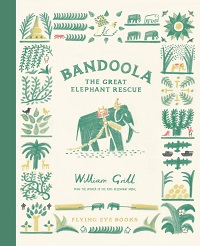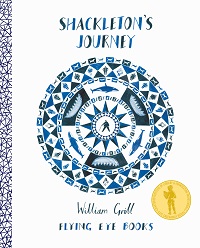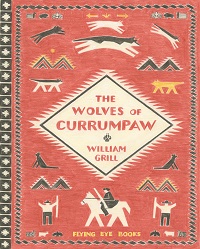Authorgraph No.256: William Grill
 I am sitting with William Grill in his office in Bristol. He has only just moved in to the Jamaica Street Studios, which houses more than twenty other artists. We are talking about his latest published title, Bandoola: The Great Elephant Rescue, and the table between us is spread with examples of his work towards the finished book: pocket sketch books, an early dummy of the book, and drawings, many drawings. It is not a large table, and it can hold so much because Will works small. Even the large atmospheric double page spreads in his books, often dominated by landscape or skyscape, are finished as drawings not much bigger than A5 and then enlarged for the final book. Will says that working small and loose is particularly important in the early stages: ‘It’s not about the quality of the drawing. It’s more about the generation of ideas.’ Even in the finished work, he believes ‘less is more’, focusing only on what he wants the illustration to convey.
I am sitting with William Grill in his office in Bristol. He has only just moved in to the Jamaica Street Studios, which houses more than twenty other artists. We are talking about his latest published title, Bandoola: The Great Elephant Rescue, and the table between us is spread with examples of his work towards the finished book: pocket sketch books, an early dummy of the book, and drawings, many drawings. It is not a large table, and it can hold so much because Will works small. Even the large atmospheric double page spreads in his books, often dominated by landscape or skyscape, are finished as drawings not much bigger than A5 and then enlarged for the final book. Will says that working small and loose is particularly important in the early stages: ‘It’s not about the quality of the drawing. It’s more about the generation of ideas.’ Even in the finished work, he believes ‘less is more’, focusing only on what he wants the illustration to convey.
Will only thought of working in art when he visited his elder brother, who was an art student at Falmouth college. Previously he had thought that he might make a career of his love of the outdoors, maybe as a mountaineering guide. And then, what his brother was doing at Falmouth seemed more exciting than art classes at school and he set off in a new, and now very successful, direction.
Bandoola is the latest of the three large format documentary narratives that he has published, each relying mainly on illustration rather than  text, mixing information and story and characterised by carefully orchestrated pages of images. There might be a mosaic of small uniform panels, each carrying the story forward, followed by a double page spread which invites the reader to linger over a scene. A William Grill book is instantly recognisable yet, in contrast to a title in a publisher-driven non-fiction series, feels personal and almost hand-crafted; and, for this, Will is happy to give some of the credit to his publisher, Flying Eye Books.
text, mixing information and story and characterised by carefully orchestrated pages of images. There might be a mosaic of small uniform panels, each carrying the story forward, followed by a double page spread which invites the reader to linger over a scene. A William Grill book is instantly recognisable yet, in contrast to a title in a publisher-driven non-fiction series, feels personal and almost hand-crafted; and, for this, Will is happy to give some of the credit to his publisher, Flying Eye Books.
Will’s first book, Shackleton’s Journey, was picked up by Flying Eye from a graduate exhibition. It was a dummy with some finished illustrations, and Will was surprised that a publisher might be interested, and really surprised when the published book went on to win international acclaim, including the CILIP Kate Greenaway Medal. Will is pleased by the way that Flying Eye have produced the books with attention to details like the binding and the paper, which is uncoated and has ‘a tooth’, much like the paper he uses for his original drawings: ‘They are books that are good to handle, and made to last and to hand down, don’t you think?’
 Each of Will’s books have been drawn from passionate interests. He first came across the story of Bill Williamson and Bandoola, the elephant, in a book that he found in a second-hand bookshop in Falmouth when he was a student. It’s the story of Bandoola, his Oozie (or trainer), Po Toke, and Williamson, a logging company manager, who together led a group of elephants and refugees out of Japanese occupied Burma (now Myanmar) during the Second World War. It shares themes with both Shackleton’s Journey and Will’s intervening book, The Wolves of Currampaw. Each explores the human relationship with a specific environment: Antarctica, the American south west, and the Myanmar jungle. They are all carefully researched information books set in the past and are also stories of heroism, adventure and endurance. Will says that he was drawn back to the photographs of elephants lifting logs in his dog-eared Penguin Classic because they also promised something different from his first two books: a story that would be more ‘animal focused’. Yes, it is a story of humans using the elephants for their own purposes, but it is also a story of elephants trained with kindness; a story of ‘trust and companionship’. And ‘Bandoola is a great central character’.
Each of Will’s books have been drawn from passionate interests. He first came across the story of Bill Williamson and Bandoola, the elephant, in a book that he found in a second-hand bookshop in Falmouth when he was a student. It’s the story of Bandoola, his Oozie (or trainer), Po Toke, and Williamson, a logging company manager, who together led a group of elephants and refugees out of Japanese occupied Burma (now Myanmar) during the Second World War. It shares themes with both Shackleton’s Journey and Will’s intervening book, The Wolves of Currampaw. Each explores the human relationship with a specific environment: Antarctica, the American south west, and the Myanmar jungle. They are all carefully researched information books set in the past and are also stories of heroism, adventure and endurance. Will says that he was drawn back to the photographs of elephants lifting logs in his dog-eared Penguin Classic because they also promised something different from his first two books: a story that would be more ‘animal focused’. Yes, it is a story of humans using the elephants for their own purposes, but it is also a story of elephants trained with kindness; a story of ‘trust and companionship’. And ‘Bandoola is a great central character’.
Research for the two latest books have included visits to New Mexico and Mayanmar. Will accepts that he might have done the books without  that, but ‘there would be a lot missing.’ In Mayanmar, he talked to present-day Oozies and experienced the heat, smells and noises of the jungle for himself. ‘I like to get deep into what I’m doing’ and, perhaps, although he does not say so exactly, the story was going deeper into him. These were his own adventures, providing a sense of first-hand excitement for the books that he could never have found ‘sitting behind a desk’.
that, but ‘there would be a lot missing.’ In Mayanmar, he talked to present-day Oozies and experienced the heat, smells and noises of the jungle for himself. ‘I like to get deep into what I’m doing’ and, perhaps, although he does not say so exactly, the story was going deeper into him. These were his own adventures, providing a sense of first-hand excitement for the books that he could never have found ‘sitting behind a desk’.
Returning to what is on the table in front of us, we talk about the development of Bandoola. Will tries to set the basic structure, or ‘the breakdown of the story’ early on: what will be included and how the spreads will work within themselves and in relation to one another. For instance, Will decided that the spread about elephant facts would work best as a central elephant image surrounded by vignettes, while he saw that the elephant logging scene would work best as a double page spread, ‘and that never really changed and I made the text fit in’.
Some of Will’s illustration technique resembles storyboarding a film, and he says that, while he doesn’t look at many illustrated books, he does watch a lot of movies. He generates a lot of practice drawings, some of which may rework the same scene in slightly different ways, from different angles or placing elements differently. The example he shows me is a grid of small drawings, no two exactly the same, portraying a line of elephants traversing the jungle. A note next to the image that is finally chosen reads, ‘mysterious and adventurous’.
In each of the books, Will has worked with a particular colour palette. For Bandoola, it is essentially the colours of the Myanmar flag, gold and green, with red as an accent. Red sometimes highlights details and sometimes, in other spreads, creates ‘a dreamier more emotional atmosphere’. In his first two titles, Will worked with coloured pencil drawings which were then enlarged and printed. For Bandoola, however, he used Photoshop to recreate something that was very like the lithography that would have been used for the original Elephant Bill. He drew in black and white, creating ‘tonal roughs’, and used these as colour separations, principally in blue and yellow, overlaying them to produce variegated shades of jungle green. It was, he says, ‘a learning curve’, but he was pleased with the result: ‘Some things worked really well. Night time scenes came through with a clearer colour gradient than if I’d used coloured pencil’.
Will accepts that he is drawn to male adventure stories, but not that he is ‘glorifying men too much’. Shackleton’s Journey is partly about the hubris that put Shackleton in danger in the first place. The Wolves of Currampaw shows how the encounter with a wolf changes Ernest Thompson Seton from hunter to early conservationist; and, in Bandoola, To Poke and Bill show what sympathy and friendship with animals can achieve. Will thinks that these kinds of stories, that are “tough and real”, should engage boy readers in particular.
He is working on something different at the moment, and not for Flying Eye. It is a book about clouds, and there is already a sheaf of drawings of many evocative, but carefully differentiated, cloudscapes. No narrative this time, but a poetic approach from Gavin Pretor Pinney, the founder of the Cloud Appreciation Society, and the author of The Cloudspotters Guide and The Wavewatcher’s Companion. It will be different from the previous books, but Will has returned to working with coloured pencils, and, as he says, making his own connection to his previous work, ‘the sky is, after all, the last great wilderness’. Something to look forward to, from a unique talent.
Clive Barnes has retired from Southampton City where he was Principal Children’s Librarian and is now a freelance researcher.
Bandoola: The Great Elephant Rescue, Shackleton’s Journey and The Wolves of Currampaw are all published by Flying Eye Books, hbk.



